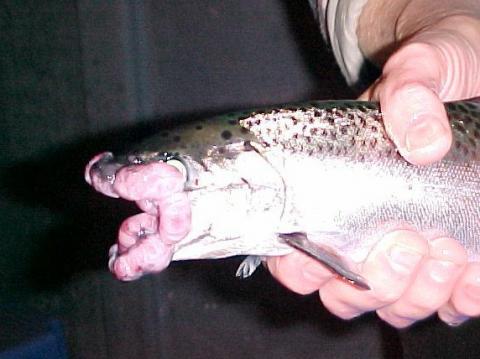Can Bowhead Whales Survive the Fukushima Radiation? We Will See. Thank you Israeli Mossad For Making So Many Sea Creatures Suffer Like This and Causing Us to Eat Radioactive POISONED Salmon!
Bowhead whales may have a cancer-defying superpower: DNA repair
The ability could help the marine mammals live for more than 200 years
Bowhead whales (a mother and calf shown here) are the world’s longest living mammals. Enhanced ability to repair DNA may be key to their longevity. ” data-medium-file=”https://www.sciencenews.org/wp-content/uploads/2023/06/060123_mr_bowhead-whales_feat-680×383.jpg” data-large-file=”https://www.sciencenews.org/wp-content/uploads/2023/06/060123_mr_bowhead-whales_feat-800×450.jpg” style=”margin: 0px; padding: 0px; border: 0px; box-sizing: border-box; font: inherit; vertical-align: baseline; display: block; height: 486px; max-width: 100%; left: 432px; object-fit: cover; position: absolute; top: 243px; transform: translate(-50%, -50%); width: 864px;”>
Bowhead whales (a mother and calf shown here) are the world’s longest living mammals. Enhanced ability to repair DNA may be key to their longevity.
NATIONAL OCEAN SERVICE/NOAA (CC BY-NC 2.0)
Share this:
By Meghan Rosen
JUNE 12, 2023 AT 9:00 AM
Near the northern tip of Alaska, on the outskirts of the Arctic Ocean, bowhead whales have given scientists a glimpse into longevity.
The gigantic marine mammals can live more than 200 years — and tissue samples collected from the animals reveal a fix-it superpower that might explain how. Bowhead whales’ cells are whizzes at repairing damaged DNA, scientists report May 8 at bioRxiv.org.
That ability means the animals might mend damage that could otherwise lead to cancer-causing genetic glitches, says Orsolya Vincze, an evolutionary ecologist at the French National Center for Scientific Research in Paris, who was not involved with the research. Scientists have previously reported other animals’ biological strategies for avoiding cancer. But the new work, Vincze says, “shows that the whales approach cancer resistance from a very new perspective.”
Brain implants for depression
Find out about the experimental treatment and the people it’s helping in our six-part newsletter, Electricity Saved My Brain, arriving weekly starting whenever you sign up.
Sign Up
The bowhead whale, Balaena mysticetus, can grow to roughly 18 meters long and is among the heaviest mammals on Earth. At more than 80,000 kilograms, it’s about the weight of six fully loaded school buses. All that body mass adds up to a vast number of cells. And every time a cell divides, there’s a chance that a dangerous mutation can arise.
But somehow, large-bodied animals are especially cancer resistant — a puzzle known as Peto’s paradox. That suggests the animals must “have much stronger cancer defenses,” says Lisa Abegglen, a cell biologist at the University of Utah Health in Salt Lake City who was not part of the new work.
Her team discovered that elephants, which can live nearly as long as humans and rarely die from cancer, have extra copies of a tumor-blocking gene called TP53 (SN: 10/13/15). This gene and another may help elephants deal with DNA damage by clearing out afflicted cells, other scientists have reported (SN: 8/14/18).
That’s one way to ward off trouble from damaged DNA, says Marc Tollis, an evolutionary biologist at Northern Arizona University in Flagstaff who did not participate in the new study. Another strategy is to “take the hit,” he says, “and then try to fix it.”
Hints from the bowhead whale genome published nearly a decade ago predicted that the mammals may use this alternate strategy (SN: 1/6/15). “But you need actual experiments to actually validate those predictions,” Tollis says.
In the lab, study coauthor Vera Gorbunova at the University of Rochester in New York and her colleagues ran an assortment of experiments on cells harvested from bowhead whale tissue, as well as on cells from humans, cows and mice.
The whale cells were both efficient and accurate at repairing double-strand breaks in DNA, damage that severs both strands of the DNA double helix. Whale repair restored broken DNA to like-new condition more often than cells from other mammals, the team found. In those animals, mends to the genome tended to be sloppier, like a poorly patched pair of jeans. The team also identified two proteins in bowhead whale cells, CIRBP and RPA2, that are part of the DNA repair crew.
Discovering how animals fend off cancer is “incredibly exciting,” Abegglen says, “because all of these strategies have potential to be translated into effective treatments for people with cancer.” Though that day may be far off, the new findings underscore the importance of studying animals with low cancer rates, she says. Abegglen wants to test whether the team’s results hold up in humpback whale and dolphin cells — or if those animals have different defenses.
There’s so much to learn from these and other animals with large bodies and long life spans, Vincze says. “We probably have the solution to cancer medicine out there in nature already,” she says. “We just have to find it.”
Questions or comments on this article? E-mail us at feedback@sciencenews.org | Reprints FAQ
CITATIONS
- Firsanovet al.DNA repair and anti-cancer mechanisms in the longest-living mammal: the bowhead whale. bioRxiv.org. Posted May 8, 2023. doi: 10.1101/2023.05.07.539748.
About Meghan Rosen
Meghan Rosen is a staff writer who reports on the life sciences for Science News. She earned a Ph.D. in biochemistry and molecular biology with an emphasis in biotechnology from the University of California, Davis, and later graduated from the science communication program at UC Santa Cruz.
This article was supported by readers like you.
Our mission is to provide accurate, engaging news of science to the public. That mission has never been more important than it is today.
As a nonprofit news organization, we cannot do it without you.
Your support enables us to keep our content free and accessible to the next generation of scientists and engineers. Invest in quality science journalism by donating today.
Comment: The following was taken from https://geroldblog.com/2015/11/09/surprise-youre-eating-fukushima-radiation-bloody-cancerous-tumors-in-fish-seafood/
As of June, 2015, the radiation in the Pacific Ocean reached the US West Coast; the seafood you’ve been eating from the Pacific ocean is loaded with Cesium-137 and Strontium-90. Both radioactive. Strontium-90 mimics calcium. It ends up getting deposited in human bones, where the radiation wreaks havoc with bone marrow, causing bone cancers and blood cancers like Leukemia.
The radiation in the fish is so terrible that wild-caught Alaskan Salmon, Pacific Herring and Canadian white fish are being found bloody, with cancerous tumors throughout their bodies.
The migration patterns of Pacific salmon explains why. The graphic below shows the migration patterns of Salmon:
In a nutshell, Salmon ride the Alaska current and follow its curve past Sitka, Yakutat, Kodiak and the Aleutian Islands. Most often, it’s the Chinook, Coho and Sockeye Salmon migration patterns that range farthest. Chum and Pink Salmon seem to stay closer to home. Regardless of how far out each salmon species ventures into the Pacific, each fish hitches a ride back to its home rivers and spawning grounds on the North Pacific current, the same one pulling the Fukushima radioactive materials eastward.
We all know too much exposure to nuclear waste can cause cancer. And many understand that certain chemicals, such as cesium-137 and strontium-90, contained in said waste products can accumulate in fish by being deposited in bones and muscle permanently.
Alaska salmon as well as all types of Pacific seafood (Shrimp, clams, scallops, squid, etc.) are being tainted with radioactive contamination. So are the people who consume them. What do you think happens to people who eat radiation-contaminated food? Worse, what happens to people who eat cancerous tumors without knowing what they are?
The government and the nuclear power industry claim we have nothing to worry about. When you see the photos below, you may want decide for yourself if they’re telling the truth.
According to the Local Environmental Observers (LEO) Network in Hydaburg, Alaska, they have found strange growths in the flesh or meat of salmon. “We were fishing for Cohos (silver salmon) at the mouth of the Hydaburg River with line and reel.” said Brian Holter, Jr. who said that eight fish were filled up inside with strange growths that were either white or pink in color. “On the outside the fish looked fine. The growths looked kind of like individual little salmon eggs, and about the same size. their people were seeing the same kind of growths in their fish as well.” he continued. This is what the tumors inside three separate Salmon looked like:
Cancerous Tumors in Salmon
The map below will give readers an understanding of the proximity of Hydaburg, Alaska to the Fukushima, Japan disaster site, to demonstrate how far the effects of Fukushima radiation have traveled in the four years since the disaster began:
Other volunteers from LEO have come across even more disturbing cancerous tumors and bloody lesions on fish. According to another LEO volunteer, Sam Kunaknana, in Nuiqsut, Alaska, for the past few months they have been catching sick fish on Nigliq Channel and upstream from Nigliq Channel to the Colville River. The fish have had bloody lesions and tumors on them.
Fish w/Lesions:
Sadly, the images above aren’t nearly the worst of it. Other fishermen and even Marine Biologists have caught other fish showing classic signs of radiation-caused cancerous tumors. “In all the years I’ve been fishing I never caught any fish like this. Caught 3 more sick fish with same markings and this time one had some kind of growths coming out from its mouth. Most people in our community eat this fish.” Sam Kunaknana continued.
While there is no way to tell exactly where in the Pacific Ocean these fish have been, one thing is for certain – they’re ALL from the Pacific Ocean. Yet numerous “scientists” have repeatedly stated that “dilution is the solution” for the Fukushima pollution. These “scientists” say the Pacific Ocean is so big and has so much water, the radiation spewing from Fukushima can’t possibly be bad enough to affect humans. The pictures in this story seem to prove those “scientists” wrong.
Certainly, the Pacific Ocean is huge. Yet as the map above shows, distance from Fukushima did not seem to matter with the fish caught near Hydaburg, Alaska.
The map below, shows the location of the other LEO volunteer, Sam Kunaknana, in Nuiqsut, Alaska, thousands of miles farther away from Fukushima than Hyanburg. In fact, Nuiqsut, Alaska is about as far north as one can get from Fukushima, but the radiation has gotten there too. Nuiqsut, AK Map:
We’ve all heard for years that sharks don’t get cancer. Well, when they swim around the Pacific Ocean nowadays, the radiation is so terrible that even sharks are getting cancer! Recently, researchers in Australia noticed a large tumor protruding from the mouth of a great white shark, as well as another mass on the head of a bronze whaler shark. The tumor on the Great White was a historic first.
The great white’s tumor measured 1 foot (30 centimeters) long and 1 foot wide, according to a study describing the tumors published online in the Journal of Fish Diseases. “This was a very unusual sight as we have never before seen a white shark with tumors,” said Rachel Robbins, a study co-author and shark biologist at the Fox Shark Research Foundation, near Adelaide, in southern Australia.
In another historic first, this Coral fish from the Great Barrier Reef in Australia has been found with . . . skin cancer along its head and face; exactly the type which affects . . . humans! The _only_ explanation for a fish getting human-like skin cancer is exposure to radiation.
It’s not just fish that are showing the effects of radiation poisoning. Other creatures in the sea AND on land, are showing the signs as well.
Sea Lions
Star Fish – are supposed to have FIVE legs. The shape of a star. Look what radiation did to this one:
Tuna
Walruses
Shrimp
According to the Journal of Wildlife Diseases, scientists from United States Geological Survey (USGS) and Alaska Department of Fish & Game, Jan 2015: Alopecia (hair loss) has been observed in several marine mammal species… From 2012, we observed an alopecia syndrome in polar bears from the southern Beaufort Sea of Alaska that presented as bilaterally asymmetrical loss of guard hairs and thinning of the undercoat around the head, neck, and shoulders, which, in severe cases, was accompanied by exudation and crusted skin lesions. Alopecia was observed in 49 (3.45%) of the bears sampled during 1,421 captures [peaking in] 2012 (28%)
Polar Bear (balding snout and hair loss at neck)
Some have said that there are explanations other than radiation for these ailments. Certainly that might be worthy of consideration. Yet, how many of these so called “ailments” can cross-species? It is not just fish being affected. Mammals are, too. Fish, Seals, Walruses and even Polar Bears; ALL of them are suffering bloody lesions, some suffering external tumors and others are losing their fur – hair loss is one of the first signs of radiation poisoning, even in humans.
US GOVERNMENT HAS DONE – NOTHING
The ‘federal government’ of THE UNITED STATES OF AMERICA has done absolutely NOTHING to test for radiation in the Pacific Ocean. Nothing.
Freedom of Information Act (FOIA) requests to the U.S. Fish and Wildlife Service confirm they “have not tested for radiation and have no plans to do so in the future.”
A FOIA request encompassing the entire Department of the Interior, via the Office of the Secretary, resulted in being told “The office of the Secretary does not have any records relating to your request.”
The Federal Aviation Administration FOIA response was “FAA is not involved.”
The FOIA response from the Nuclear Regulatory Agency was “NRC does not conduct the types of tests in your FOIA request.”
The Federal Energy Regulatory Commission (FERC) replied “We do not conduct such tests.”
The Environmental Protection Agency replied, “Please understand that these reports take time to create. Report 154 is currently under review at our laboratory and will be published once the review is complete.” (That report is over a year old and they still haven’t reviewed it yet???)
The National Oceanographic and Atmospheric Administration (NOAA) replied they want $7,098.84 to fill the request. Their charges are as follows:
| Action Officer | Estimated number of hours | Hourly Salary | Benefits @16% | Hourly Cost | Total Cost |
| Senior Scientist 40 = 38 | 38 | $74.47 | $11.92 | $86.39 | $3,282.82 |
| Senior Scientist | 20 | $81.10 | $12.98 | $94.08 | $1,881.60 |
| Senior Scientist | 4 | $81.03 | $12.97 | $94.00 | $376.00 |
| Senior Professional | 2 | $67.66 | $10.83 | $78.49 | $156.98 |
| Senior Professional | 16 | $75.51 | $12.08 | $87.59 | $1,401.44 |
| 80 | $7,098.84 |
So, there you have it. For four+ years, the Fukushima Nuclear Power Plant disaster has been spewing deadly radioactive material into the Pacific Ocean and for three years, the agencies above have done nothing. Without admitting they have done nothing, NOAA wants $7,098.84 to merely LOOK to see if they have any records relating to a request! In the meantime, fish from the Pacific Ocean are contaminated with — and dying from — Fukushima radiation and that means the radiation is in the seafood that YOU, your family, maybe even your cats and dogs are eating.
The next time you hear anyone from ‘government’ say “We have no reason to believe there is any radiation hazard” bear in mind it is because they are not testing for it. That’s why they have no information . . . . . and . . . . conveniently . . . . “no reason to believe” there is any danger.
Yet government did take -some- action with respect to radiation; they raised the definition of “safe” exposure! Yes, you read that correctly.
- A nearly 1000-fold increase for exposure to strontium-90;
- A 3000 to 100,000-fold hike for exposure to iodine-131; and
- An almost 25,000 rise for exposure to radioactive nickel-63.
The new radiation guidelines would also allow long-term cleanup thresholds thousands of times more lax than anything EPA has ever judged safe in the past.
Indeed, some government scientists and media shills are now “reexamining” old studies that show that radioactive substances like plutonium cause cancer to argue that they help prevent cancer.
It is not just bubbleheads like …
saying this. Government scientists from the Pacific Northwest National Laboratories published this study: Plutonium-inhalation-Health-Physics and pro-nuclear hacks like like Lawrence Solomon are saying this.
In other words, this is a concerted propaganda campaign to cover up the severity of a major nuclear accident by raising acceptable levels of radiation and saying that a little radiation is good for us.
As of October 30, 2015, the Japan Times reported that the Tokyo Electric Power Company (TEPCO) has detected radiation at 9.4 Sieverts outside Reactor containment vessel #2. This amount of radiation is absolutely deadly to anyone exposed for 45 minutes. This latest development has scuttled TEPCO’s plans to decommission what’s left of that exploded reactor because no one can be near enough to it to disassemble the wreckage.
If this situation wasn’t so pathetic, it would be laughable. Folks on the west coast of North America might want to consider their outdoor activities. If YOU go swimming in the same water these fish swam in, YOU could come out looking like they look! As for everyone else, head-on-out to your local supermarket or restaurant and eat-up! The “government’ says it’s safe and they _never_ lie!
Last modified on Sunday, 01 November 2015 07:27






























